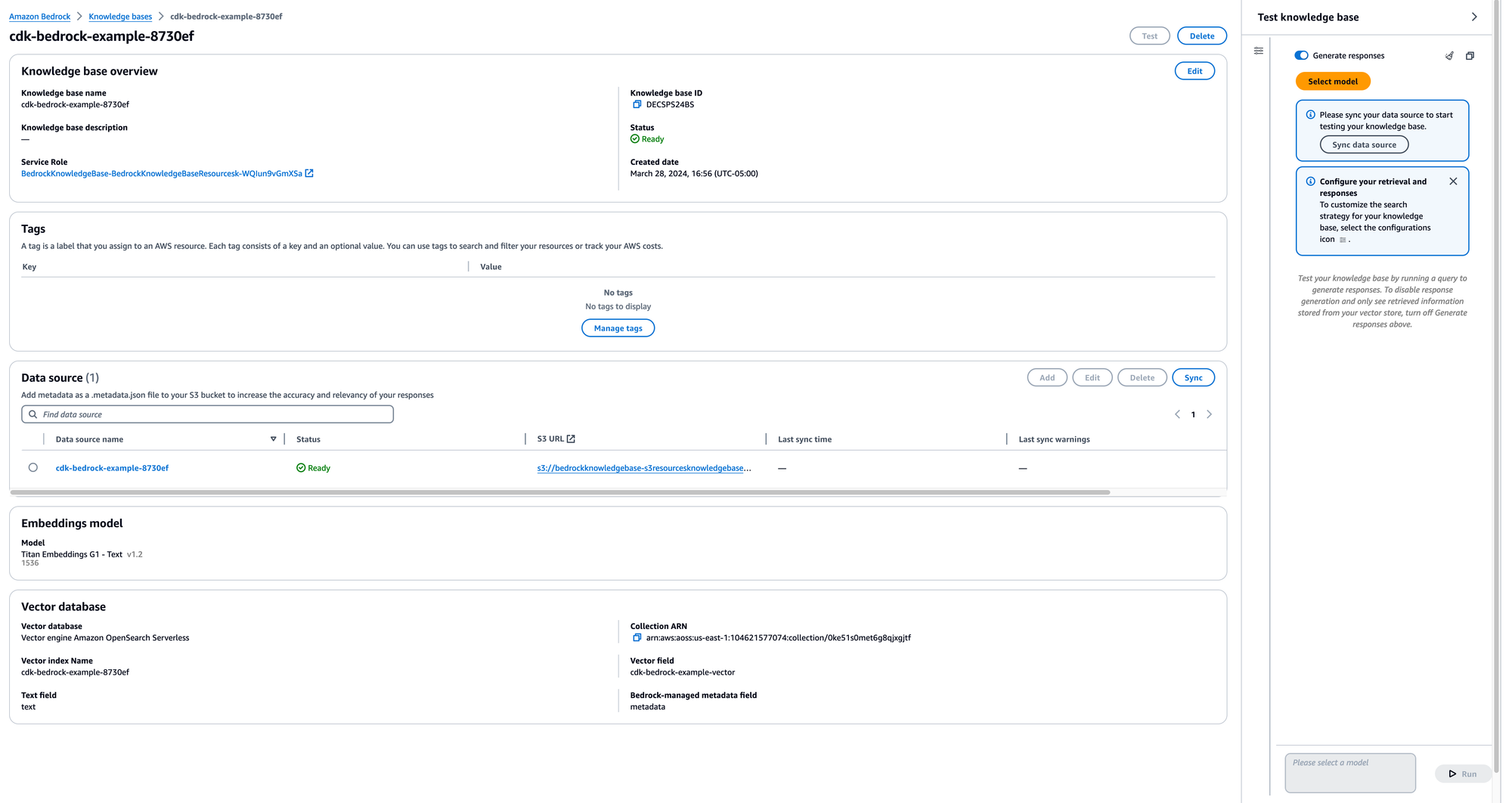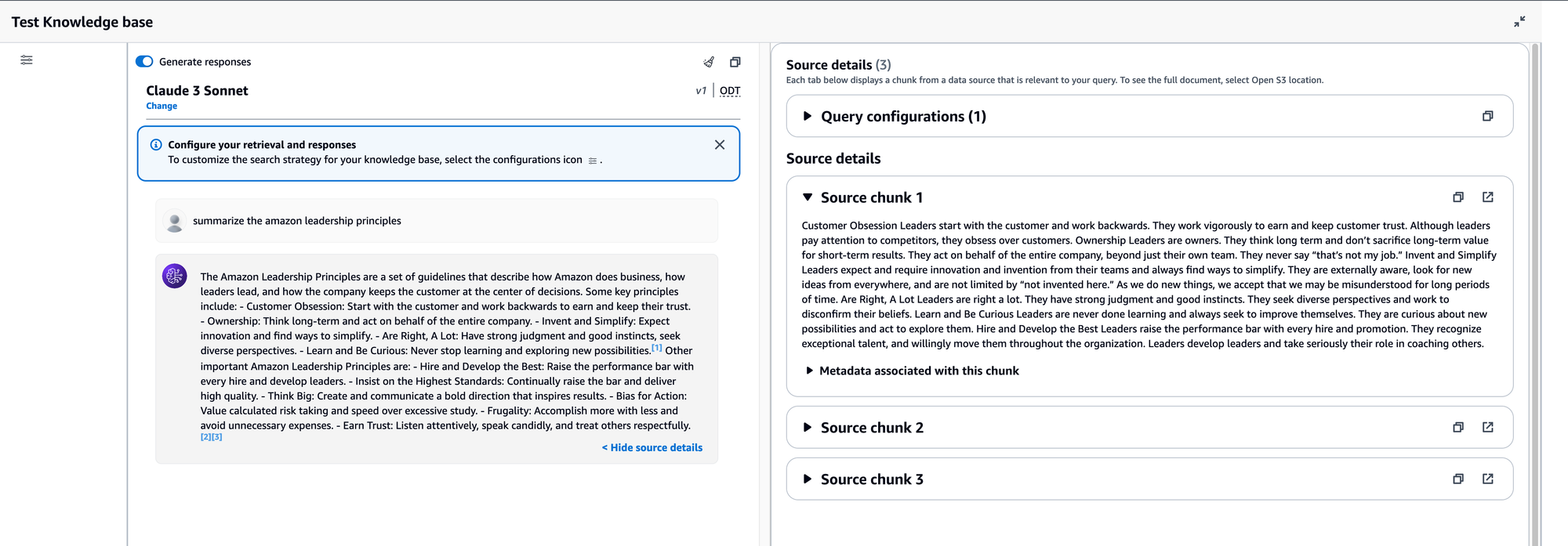In this demo, we'll see how to deploy a Knowledge Base for Amazon Bedrock with Amazon OpenSearch as the vector store using CDK. Deploying a Knowledge Base requires severals steps that will be accomplished using a Custom Resource. This Custom Resource will build resources following this basic guide: https://docs.aws.amazon.com/bedrock/latest/userguide/knowledge-base-create.html
- Create Bucket
- Create Vector Index
- Create Access Policy
- Create Network Security Policy
- Create Encryption Policy
- Create Collection
- Create Index
- Create Knowledge Base
- Create Data Source
This demo also includes a Lambda function that will StartIngestionJob when a new object is created in the Bucket to automatically sync the Data Source with the Knowledge Base.
Custom Resource Configuration
Due to the complex nature of Knowledge Bases, many fields are statically defined in this demo that can and should be customized.
Names
This CDK deployment uses two names for configuring the resources used - a namePrefix and nameSuffix. The namePrefix can be defined in a .env file:
NAME_PREFIX='sample-name'
The nameSuffix will be generated during deployment and used throughout. The result is that most resources will be named: namePrefix-nameSuffix.
Access Policy
const parsedArns: string[] = JSON.parse(accessPolicyArns);
const principalArray = [
...parsedArns,
knowledgeBaseRoleArn,
knowledgeBaseCustomResourceRole,
];
const policy = [
{
Rules: [
{
Resource: [`collection/${namePrefix}-${nameSuffix}`],
Permission: [
"aoss:DescribeCollectionItems",
"aoss:CreateCollectionItems",
"aoss:UpdateCollectionItems",
],
ResourceType: "collection",
},
{
Resource: [`index/${namePrefix}-${nameSuffix}/*`],
Permission: [
"aoss:UpdateIndex",
"aoss:DescribeIndex",
"aoss:ReadDocument",
"aoss:WriteDocument",
"aoss:CreateIndex",
],
ResourceType: "index",
},
],
Principal: principalArray,
Description: "",
},
];
For example, this Access Policy will be applied to the OpenSearch Collection that is created. This will include the necessary Roles for the deployment, as well as any users or roles you would like to add. In order to access the Collection and Index within the Console, you will need to add the appropriate role or user.
const bedrockKnowledgeBase = new CustomResource(
this,
"KnowledgeBaseCustomResource",
{
serviceToken: knowledgeBaseProvider.serviceToken,
properties: {
knowledgeBaseBucketArn: props.knowledgeBaseBucket.bucketArn,
knowledgeBaseRoleArn: this.knowledgeBaseRole.roleArn,
knowledgeBaseCustomResourceRole: knowledgeBaseCustomResourceRole.roleArn,
accessPolicyArns: JSON.stringify([]),
nameSuffix: Names.uniqueId(this).slice(-6).toLowerCase(),
namePrefix: props.namePrefix,
knowledgeBaseEmbeddingModelArn:
"arn:aws:bedrock:us-east-1::foundation-model/amazon.titan-embed-text-v1",
},
},
);
Collection
const createCollectionResponse = await openSearchServerlessClient.send(
new CreateCollectionCommand({
clientToken: randomUUID(),
type: "VECTORSEARCH",
name: `${namePrefix}-${nameSuffix}`,
}),
);
A VECTORSEARCH type Collection will be created that will use the previously created policies.
Index
Once the Collection is created, a k-NN index will be created. See: https://opensearch.org/docs/latest/search-plugins/knn/knn-index/ for more details on configuring your Index.
var createIndexResponse = await client.indices.create({
index: `${namePrefix}-${nameSuffix}`,
body: {
settings: {
"index.knn": true,
},
mappings: {
properties: {
[`${namePrefix}-vector`]: {
type: "knn_vector",
dimension: 1536,
method: {
name: "hnsw",
engine: "faiss",
parameters: {
ef_construction: 512,
m: 16,
},
},
},
},
},
},
});
Knowledge Base
Once the Collection and Index have been created, the VECTOR Knowledge Base using OPENSEARCH_SERVERLESS will be created.
const data = await bedrockAgentClient.send(
new CreateKnowledgeBaseCommand({
clientToken: randomUUID(),
name: `${namePrefix}-${nameSuffix}`,
roleArn: knowledgeBaseRoleArn,
knowledgeBaseConfiguration: {
type: "VECTOR",
vectorKnowledgeBaseConfiguration: {
embeddingModelArn: knowledgeBaseEmbeddingModelArn,
},
},
storageConfiguration: {
type: "OPENSEARCH_SERVERLESS",
opensearchServerlessConfiguration: {
collectionArn: collectionArn,
vectorIndexName: `${namePrefix}-${nameSuffix}`,
fieldMapping: {
vectorField: `${namePrefix}-vector`,
textField: "text",
metadataField: "metadata",
},
},
},
}),
);
Data Source
Finally, a Data Source will be added using the previously created S3 Bucket.
const dataSourceCreateResponse = await bedrockAgentClient.send(
new CreateDataSourceCommand({
knowledgeBaseId: knowledgeBaseId,
clientToken: randomUUID(),
name: `${namePrefix}-${nameSuffix}`,
dataSourceConfiguration: {
type: "S3",
s3Configuration: {
bucketArn: knowledgeBaseBucketArn,
inclusionPrefixes: ["knowledgeBase"],
},
},
}),
);
Result
We can see the the Knowledge Base has been created, but we still need to select a Model and Sync our data.

Let's select Claude 3 Sonnet for our Model.

And now, let's upload a file to the knowledgeBase folder in our S3 Bucket. This will automatically trigger a StartIngestionJob that will sync our Data Source with our Knowledge Base.

Now we can test our Knowledge Base with the uploaded file and get the results back from the uploaded document.

GitHub
This demo can be found on GitHub here: https://github.com/schuettc/cdk-bedrock-knowledge-base
Deploy
To deploy this demo:
yarn launch
To destroy this demo:
yarn cdk destroy
